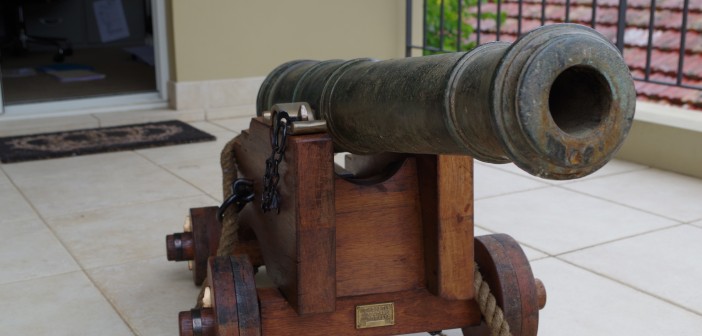Every man space has that one special item; the ‘jewel in the crown’, if you will. It might be the dream car, a signed piece of memorabilia, a rare item that completes the set…
For Mike Bartlett it is a cannon. Yes, that’s right, a cannon. If you’d like to be a little more specific, a cannon built in 1769 for the Dutch East Indies Company.
Now, that’s a little bit different.
Mike lives in a very scenic area of Sydney with magnificent established trees and undulating land. The cannon sits on a balcony a couple of levels up looking out over the trees towards the city centre. Mike often works from home and the balcony is an extension of his home office, so he gets to enjoy the view, complete with his cannon, every day at his desk.
The size is not massive by ‘cannon standards’, but its beauty is in the authenticity. The bronze barrel is etched with the maker’s mark and reads, ‘P. Seest A’ referring to the foundry Peter Seest in Amsterdam, who made hardware for the Dutch East Indies Company. It also has the etching of the Dutch East Indies Company logo as acknowledgement of who commissioned it.
“The barrel is the old part, and that’s obviously the bit that everyone is interested in,” says Mike. “When I got my hands on it there was no carriage, so I got one made to order by a specialist back in Australia.”

For those who aren’t familiar, or perhaps have forgotten their Year Eight history classes, the Dutch East Indies Company was a chartered company established by the States-General of the Netherlands to undertake trade and colonial activities throughout Asia. At a time of great naval trading and colonial empires, the Dutch East Indies was by far the most successful of the Asia trade operators.
Much of this era spawned from the famous spice trades of the late 1500s where the Dutch and Portuguese reigned supreme. With the trading of the world always based on supply and demand, common spices now found in any pantry or kitchen cupboard were considered to be incredibly valuable to the European market – more significant than the likes of gold or silver. As such, there was fierce competition throughout the Southeast Asia area. The Dutch East Indies Company was given incredible power by its government and renowned as ruthless in its operation.
“Although these were officially merchant ships made for transporting goods, it was a time filled with naval battles, so these cannons – along with many others of different sizes – were used on the ships for armour and protection,” explains Mike.
“However, when you do a little research you find that these small cannons were also used as counter weights. So, at one point in time they would be there for protection, but in more peaceful periods the ship may be loaded up in the Netherlands and the cannons used as ballast. When they got to their destination and didn’t need that weight – or if they needed more space – they would literally throw the small cannons overboard and leave them.”
The sheer fact they would dump these hand-built bronze cannons for some pepper and cloves does indeed demonstrate the value put on spices at the time.
“That means that a number of these models have actually been found lying around in the jungle in countries like Indonesia and Malaysia.”
So does Mike know if his cannon was part of classic naval warfare?
“Realistically, unless you pull one off a sunken vessel you can’t really tell the exact history. I’d like to say it was part of an epic battle, but the truth is… no one really knows.”
In fact, Mike’s cannon came from a farmer in Kentucky, USA, who had picked it up while travelling in Malaysia. He then took it back home, but it sat in his shed for 30 years and he never got round to building a carriage or putting it on display. As such, he put it up for sale.
While it’s fantastic to think that a man in Australia could get in touch with a farmer in Kentucky so that a magnificent piece of history could be restored and saved for future generations, you can’t help but wonder how the two would come into contact.
“Can you believe there is a place online called cannonsuperstore.com?” replies Mike.
Having written for this magazine for almost two years and seen some of the amazing things guys do and the lengths they go to… yes… strangely I can believe that.
“Over a period of quite a few years I’d looked at various things as they came up, some through auction houses and others through contacts I’d built or established along the way. And then one day I must have typed in something a bit different into Google, and up comes cannonsuperstore.com and I couldn’t believe it.
“The internet is brilliant like this. It’s one thing to consider you might be able to find one online, but who would have thought there would be a dedicated site?”
Even then, it still took a good year for something to come up that Mike was interested in. It should also be noted that he did not just wake up one day and decide he wanted a cannon (which is a good thing… I personally don’t think anyone who wakes up one day wanting a cannon should be allowed to own one), but it was an idea that had been floating around in his head for many years.
“Sometimes you just have an affection for something, without a specific reason or moment why. My dad was a navy man of 40 years and his father before him was a navy man as well, so I suppose I’ve always felt like there is a bit of seafaring blood in me. Even as a kid I used to love books that were based around large ships, the navy and shipping adventures.
“In that sense, I think the idea of owning one was lurking in the back of my head, but there are practicalities of life that stop you from doing it at various points. But then I reached a point where I realised you can always make excuses, but sometimes you just have to put those behind you and jump in.”

This lingering interest meant that Mike was quite settled on what sort of size and style he wanted to get his hands on.
“As an armourment… well, it wouldn’t have been a lot of use,” he laughs. “Against some of the ships from those days it would have simply bounced off the side, but they still served a purpose. Something of this proportion would be loaded with ammunition roughly the size of a golf ball and could get a good 1,000 yards in distance – so that can still do a bit of damage in the right scenario.
“But this is exactly the size I wanted. You see things for auction or sale that are just enormous – and while you think it may be fun it’s just not practical. I mean, there are cannons that weigh five tonne or more; I think they really belong in the park or some view point of public land.”
Even with the benefit of a dedicated website, it still took some time for an appropriate item to come up for sale. When it did, Mike was ready to commit, but hadn’t actually considered what would be involved to actually make the transaction.
“I’m not entirely sure what I expected. It was fairly straightforward, yet a little unreal at the same time. The site is effectively just a portal for people to buy and sell – they don’t broker or take any responsibility. So, once you’ve settled on something, you simply negotiate the price a bit and then settle on a final amount. Then you’ve got to put the money in the guy’s account which, to be honest, was a little daunting as I never got to meet him and didn’t know much about him, so I was just depositing cash hoping that he would come through with his end of the deal!”
Despite a little agonising, Mike took the plunge and – as evidenced by this article – the farmer in Kentucky came through with the cannon.
However, even once Mike had made the purchase; it still took roughly another year to get it into the country and through customs.
“The easy thing is buying it and organising freight, but getting it into the country was far more difficult than I could have imagined,” he says. “Part of it was quite obviously my lack of experience in doing something like this… but then again, I don’t know too many people who are experienced in bringing a cannon into Australia!
“To be fair, I bought it without actually considering what would be involved. When you do sit down and think, it’s understandable that the police, customs and officials would be pretty interested in someone bringing in a cannon.”
The first hurdle was getting it cleared with the local police as customs won’t even consider looking at a request such as this until the relevant paperwork has been signed off by the police. However, in Mike’s case, both groups proved to be difficult.
“I suppose I can understand it on one level, but there appears to be a stock-standard response of ‘no’ with the police. Most people would hope that they would be cautious, but there didn’t appear to be any consideration as to whether the item was antique, collectable or unique in any way.”
In reality, the Firearms Act states that any weapon made prior to 1910 doesn’t actually need a permit or licence; however Mike was told differently so he set about getting one. The irony is that he can now, legally, go out and buy many more guns – even though he has absolutely no desire or intention to do so.
With his licence in hand – despite not actually legally needing one – Mike went back to the police but was again refused.
“On the advice of some friends, I went through the Firearms Act carefully and produced it in front of the authorities, highlighting that my cannon was built prior to 1910. But I was told that the Firearms Act related to weapons and not cannons, and so we started an all new discussion about the definition of a cannon versus a weapon.”

Who said there was bureaucracy in government…?
“So in the end I had to reach for a legal gun in the form of my good friend Ian Smith from Sydney law firm Harris & Company who had a bit of a laugh at it and thought it was all very interesting. They assigned someone to the case and four weeks later I was told that it had all been approved.”
However this was just the New South Wales Police and Mike hit many of the same hurdles when it hit Australian Customs.
“Unfortunately I’d already contacted the farmer and told him I was good to go, so he put it on the ship, but I hadn’t considered that I’d have more troubles with customs, so it ended up sitting in the bond store for a good four months. Thankfully, we got there in the end.”
While Mike was understandably thrilled to get his cannon, what he didn’t expect was how it would expose him to a whole new world – that of the cannon enthusiast.
“I’ve had a fair bit of help from the Newcastle Gunworks. I came across them when I was looking for someone who might be able to help build a carriage. They’re a great bunch of guys who have helped in a number of different ways. It’s pretty clear I’m new in the cannon world but they’re helpful and positive towards me which is great.
“These guys not only build carriages, they can also build new cannons as well. Like many pastimes, there are groups that meet regularly and help each other as any club would for their particular interest. There are special days each year where you can bring your cannon and – under strict guidance obviously – blast away and go target shooting and more.”
I know it’s commonplace to meet and shoot targets with guns, but I never imagined people would do the same with cannons. I guess there are people who are always after a little more oomph – a bit like going from cigarettes to cigars perhaps.

“Dave Roberge from the Newcastle Gunworks helped tremendously with the building of the carriage; he’s done massive amounts of work in restoration on major projects so I knew I was in good hands.
“He helped work through designs and materials and was incredibly detailed in the planning and construction. In the end I decided to go with a replica of an English carriage rather than the traditional Dutch. I agonised long and hard about that decision, but I was eventually convinced that the Dutch carriages don’t look very good so we went with the English look. I was also reminded that it was very common for any cannon or weapon to be taken by a rival ship in battle and then fitted to that new ship with the local carriage, so there are no guarantees how many different mounts it had in its life before me anyway.”
When you see the carriage in person you realise the level of craftsmanship and work that has gone into it. The woodwork is precise, the hand-cast levers and catches immaculate, and it was meticulously put together over a number of months.
It is a fitting completion to the dream, not just in its look and quality, but also to Mike’s philosophy of remaining patient for the ultimate result.
“It was a long journey when I think about it,” he laughs. “But I do love it and every time I look at it I think it was definitely worthwhile.”
So, if you’re like me, and your first question was always going to be ‘why would you buy a cannon’, then the only true and honest answer is obvious: ‘why not?’ There are too many things we say we will do ‘one day’ but never actually get to it, but once you commit, the journey can often be as interesting as the result.





